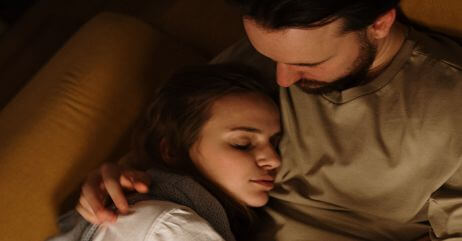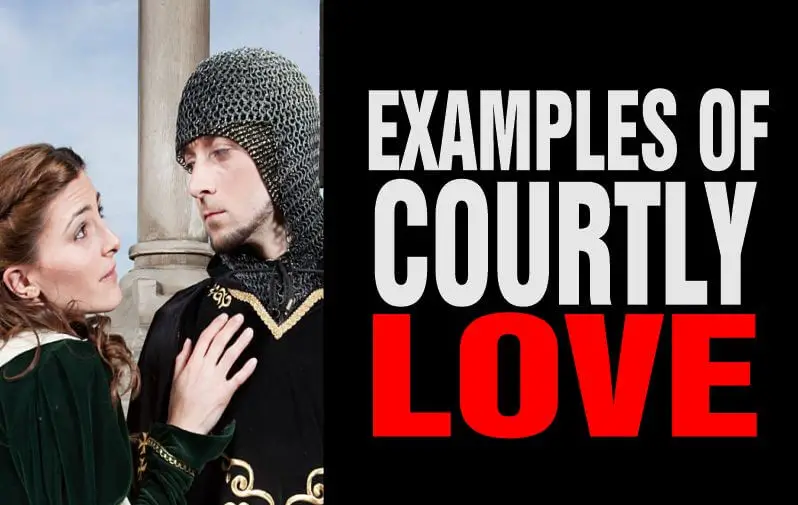These examples of courtly love buttress the courtly romances that happen between medieval knights and noblewomen.
Courtly love is a concept that emerged in medieval Europe, particularly during the period of the troubadours.
It was a type of love that was highly idealized and centered around a noble knight expressing his devotion to a lady of high social standing, usually married or unattainable.
With rules guiding the courtly romance, it was highly unattainable and unconsummated.
Examples of courtly love can be found in literature, such as the famous story of Lancelot and Guinevere or the poems of troubadours like Bernart de Ventadorn.
The idea of courtly love was characterized by chivalrous acts, secrecy, and intense desire, often portrayed through acts of devotion, longing, and sacrifice.
These examples of courtly love provided a romantic and imaginative escape for the aristocratic class during medieval times.
Table of Contents
Examples of Courtly Love

1. Lancelot and Guinevere
Lancelot and Guinevere’s courtly love in Arthurian legend epitomizes the medieval concept of idealized love.
Lancelot, a knight of King Arthur’s Round Table, deeply loves Queen Guinevere despite her marriage to Arthur.
Their love is marked by intense longing, devotion, and chivalrous admiration.
Lancelot, despite their forbidden romance, becomes the embodiment of loyalty, bravery, and sacrifice.
In the Arthurian tales, Lancelot’s membership in the Round Table makes him renowned for his skill and valour.
Guinevere, Arthur’s wife, is depicted as beautiful and intelligent.
Eventually, they foster a forbidden love, embodying courtly love’s key features. This entails an unconsummated emotional bond, secret messages, and hidden feelings, intensifying their relationship’s allure.
The dynamic revolves around idealized, unattainable love. Guinevere represents an unattainable, superior figure, while Lancelot is the devoted, loyal knight yearning for her.
This dynamic of longing and unrequited love heightens the romantic tension.
Chivalry and devotion also characterize courtly love, challenging Lancelot to prioritize his feelings over loyalty to Arthur. This struggle is central to the Arthurian legend’s conflict.
Ultimately, Lancelot and Guinevere’s courtly love tells a complex, tragic tale delving into desire, temptation, loyalty, and betrayal.
Their forbidden romance challenges knightly ideals, adding layers to the Arthurian saga.
2. Tristan and Isolde
Tristan and Isolde epitomize courtly love. The tale follows Tristan, a knight, escorting Irish princess Isolde to Cornwall for her marriage to King Mark.
They inadvertently consume a love potion, sparking a forbidden, passionate bond.
The story vividly illustrates courtly love. It encompasses intense, spiritual love beyond physical desire.
Tristan and Isolde’s connection transcends societal norms, emphasizing idealized love’s purity. Their union elevates them above the mundane.
Secrecy and yearning are also hallmarks of courtly love. Their love remains hidden due to Isolde’s engagement to Tristan’s uncle, King Mark.
Devotion and sacrifice emerge as they prioritize each other’s well-being.
Tristan’s unwavering admiration for Isolde exemplifies the noble aspect of courtly love. Their unequal dynamic embodies knightly worship.
Tragically, their love faces insurmountable obstacles. Openly being together betrayed King Mark, leading to perpetual longing.
Tristan and Isolde’s romance reflect courtly love’s essence—intense, idealized, secretive, and sacrificial, exploring love’s complexities within societal bounds.
3. Romeo and Juliet
Romeo and Juliet, written by William Shakespeare, is a quintessential example of courtly love in Renaissance literature.
The play reflects the idealized and often unattainable love that characterized the courtly love tradition during the medieval period.
The courtly love theme is prominent throughout the play, as it portrays the intense and passionate love affair between Romeo and Juliet.
Their love is not only a forbidden romance due to their feuding families, but also embodies the courtly love ideals of secrecy, adoration, and sacrifice.
In courtly love, the lovers often express their admiration through poetic language and gestures of devotion.
Romeo’s poetic declarations of love towards Juliet and their clandestine meetings in the Capulet orchard exemplify courtly love conventions.
Moreover, Juliet’s willingness to sacrifice family ties and societal expectations for her love for Romeo further illustrates the theme of courtly love.
Ultimately, Romeo and Juliet’s tragic fate, driven by their families’ enmity, aligns with the courtly love tradition, highlighting the notion that true courtly love is often thwarted by societal constraints.
Through their ill-fated romance, Shakespeare adeptly explores the complexities, struggles, and consequences inherent in the courtly love tradition of the Renaissance era.

4. Dante and Beatrice
Dante and Beatrice represent a classic example of courtly love, a concept prevalent during the medieval period. Dante Alighieri, an Italian poet, fell deeply in love with Beatrice Portinari, a noblewoman he encountered in his youth.
Their relationship epitomized the ideals of courtly love, characterized by devotion, admiration, and a yearning for an unattainable beloved.
Dante’s unrequited love for Beatrice became the central theme of his poetry, particularly in “La Vita Nuova” and “The Divine Comedy.”
In courtly love, the loved one, often a lady of higher social standing, serves as a source of inspiration and purity for the poet or troubadour, who expresses his devotion through poetry and literature.
A sense of reverence and admiration pervades this type of love, transcending the physical and focusing on the spiritual connection between the lovers.
Dante’s adoration of Beatrice embodies courtly love’s ideals of chivalry, worship, and self-sacrifice.
Their story also captures the longing for an idealized, ethereal love, which serves as a metaphor for the spiritual quest for salvation in Dante’s “The Divine Comedy.”
Beatrice represents divine love, drawing Dante closer to God through her beauty and virtue.
Ultimately, Dante’s love for Beatrice becomes a conduit for his spiritual enlightenment, exemplifying how courtly love can transcend the human realm and guide individuals towards a higher spiritual understanding.
5. Penelope and Odysseus
Penelope and Odysseus are a timeless example of courtly love within the classic poem, “The Odyssey,” written by Homer.
Their relationship epitomizes the ideals and conventions of courtly love, which emerged during the medieval period.
Courtly love is characterized by a noblewoman or wife, the lady, being idealized and unattainable for the knight or suitor, the lover.
In this context, Penelope, the chaste and faithful wife of Odysseus, represents the unattainable lady.
While Odysseus is away for twenty years, Penelope remains loyal, a virtue admired in courtly love. She patiently waits for his return, resisting the numerous suitors vying for her hand.
Odysseus, in turn, demonstrates his unwavering devotion to Penelope, even in the face of numerous temptations and obstacles on his journey back home.
Their love is characterized by longing, sacrifice, and ultimate reunion, central themes in courtly love.
Furthermore, Penelope’s weaving and unraveling of the shroud symbolizes her loyalty and determination to remain faithful to her absent husband.
Their enduring love story embodies the ideals of courtly love, showcasing the purity, devotion, and admiration found within this medieval tradition.
These examples illustrate courtly love through themes of unrequited longing, admiration, self-control, loyalty, and sacrifice. They showcase the concept of a noble and chivalrous love, built on idealized devotion and restrained pursuit.
Conclusion
Courtly love has been a prevalent theme in literature for centuries, depicting idealized and sometimes unattainable love of the medieval period.
Through the five examples discussed – Tristan and Isolde, Lancelot and Guinevere, Penelope and Odysseus, Romeo and Juliet, and Dante and Beatrice – we can see the common elements of courtly love, such as longing, secrecy, and sacrifice.
Each of these relationships demonstrates the complexity and intensity of courtly love, often resulting in tragedy or unfulfilled desires.
Despite the challenges and unrealistic expectations, courtly love has captivated readers and continues to be an enduring motif in literature, reminding us of the power and beauty of love, even in its most unattainable form.
References:
- https://www.lordsandladies.org/courtly-love.htm
- https://www.ipl.org/essay/Examples-Of-Courtly-Love-In-Twelfth-Night-FKMF83PMUXFV
- https://www.poetrysoup.com/poems/courtly_love
Pyo Merez is a men’s lifestyle enthusiast and writer about the gentleman’s place and impact on society. Raised by a distinguished gentleman dad, he offers unique insights into how the mind of a gentleman works and how societal norms shape gentlemen’s identity and vice versa.
Through his insightful articles, Pyo taps into the depths of gentleman culture to provide perspectives on etiquette and manners in modern society.

